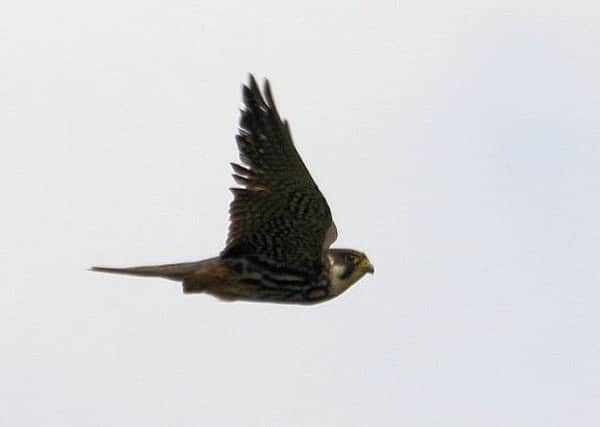Birdwatch: Speedy predator hot on the trail over its prey over the seas


This neat little falcon, slate grey, finely streaked below and with red feathering on its thighs and a black moustache, is built for high speed pursuits and is the only falcon capable of taking even swifts on the wing.
It chases small birds or beetles through the sky on swept back wings that give it the appearance of a large swift, swooping down and turning at the last moment to seize its prey with claws uppermost.
Advertisement
Hide AdAdvertisement
Hide AdLater on, as more dragonflies take flight, the hobby will take more of these, eating them on the wing after stripping off the indigestible outer casing with a cycling motion of its talons.
But sometimes even a hobby will meet its match. I heard of one last week that was so intent on chasing a flock of sand martins that it was ambushed and eaten by a peregrine falcon.
Hobbies have become much more widespread over the past 25 years.
Once they were largely confined to the heathlands of southern England and in Yorkshire the only reliable place to watch them in action was from the viewing platform in the middle of Thorne Moors near Doncaster.
But now they are seen all across the county.
Advertisement
Hide AdAdvertisement
Hide AdSo far this year up to 11 hobbies have been seen over Thorne Moors and a rare vagrant from eastern Europe, a first summer female red-footed falcon was first seen there on Sunday and was still present this week. Another female, an adult, was photographed on Monday morning at Swillington Ings, Leeds.
On the Yorkshire coast, bird ringers on the Filey Country Park caught a male bluethroat of the red spotted form on its way back to breeding sites in northern Europe or Scandinavia. This stunning bird lingered in the same area from early morning throughout the day and was still there the next giving lots of birdwatchers chance to admire it.
Less obliging has been an elusive stone curlew at Seamer Meads, Scarborough while a melodious warbler and singing firecrest were at Kilnsea.
Easterly winds brought large numbers of black terns to the region, blown off course as they migrate back to marshlands in eastern Europe and most sites have been visited by some of these elegant birds.
Advertisement
Hide AdAdvertisement
Hide AdMaking their way back to the same area, two whiskered terns were seen on the Saltholme reserve, Teesside, this week while there have been more Arctic terns on their way further north.
Wood sandpipers, sanderlings, knots and turnstones have been seen at a number of inland sites while a Temminck’s stint was at Banks Lane Lake, Scorton, North Yorkshire and two little stints and two grey plovers at the North Cave wetlands, East Yorkshire.
A spoonbill has been present on the moat at the Fairburn Ings reserve.
The male Montagu’s harrier has returned to Blacktoft Sands to join the female that was waiting for him for over a week, much to the relief of staff on the reserve.